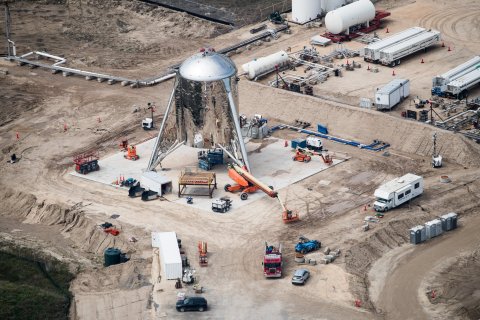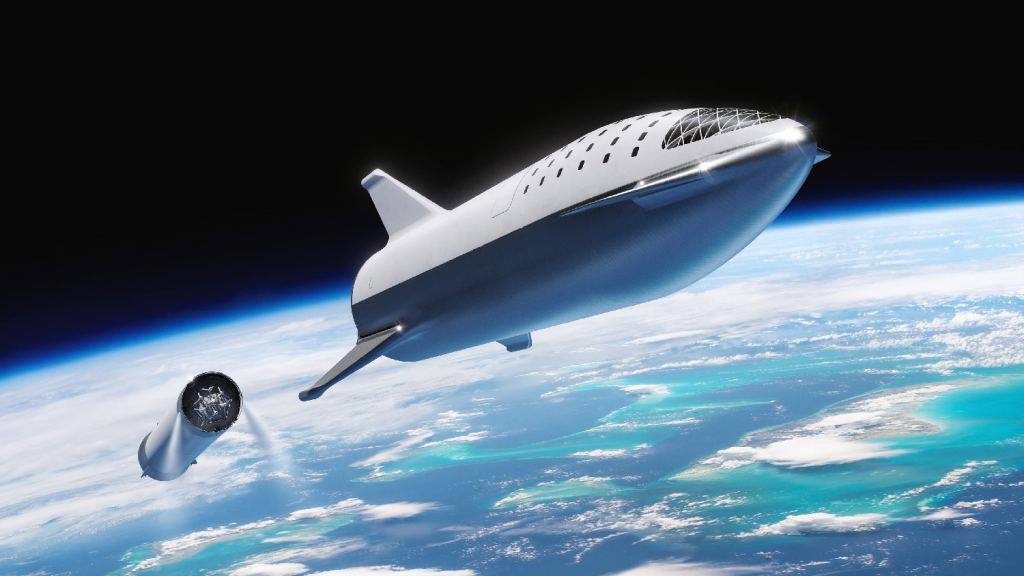SpaceX is continuing with the development of their Starship Hopper, a miniature, stainless steel version of its proposed super-heavy lift vehicle known as the Starship. Most recently, test were conducted on the revolutionary heat shield that will protect the Hopper once it reenters Earth’s atmosphere, and a new rendering was released that showed the final version entering the atmospheres of Earth and Mars.
Another recent development has to do with the first scheduled test of the miniature Starship, which began in earnest last week. Unfortunately, there has been a bit of a delay due to some technical issues with the cryogenic fuel tanks. As usual, Musk made the announcement via twitter in response to questions about when the much-anticipated flight test will happen, which has been delayed multiple times now.
Musk issued the announcement during a conversation about a recent article penned by UT’s own Fraser Cain – “The Incredible Challenge of Landing Heavy Payloads On Mars“. After being asked when the Starship Hopper will be able to conduct its first hop test, Musk tweeted, “Some challenges with ice formation in the cryogenic propellant prevalves. Hopefully overcome soon.”

This is the second apparent delay suffered by the Starship Hopper since it completed assembly. The first was experienced back in late January when the prototype was knocked over by 80 km/h (50 mph) winds, damaging the nose cone. However, a few weeks later, the prototype was refitted to fly without the nose section and SpaceX was back in the news with its first successful (and record-breaking) Raptor engine test.
These problems have inevitably pushed back the date of the hop test, which Musk hoped to conduct by late February. This tentative testing period was set by Musk back on Jan. 5th, 2019, shortly after the SpaceX crew had finished construction on the Hopper. “Aiming for 4 weeks, which probably means 8 weeks, due to unforeseen issues,” he tweeted.
And while the company issued a notice to the residents of Boca Chica about possible testing late last month, and law enforcement assisted in creating a “safety zone perimeter” around the site (closing it off to local traffic), very little was seen taking place – aside from some smoke and loud noise. As was reported by the local publication, The Monitor, on March 27th:
“After a few hours of no sounds coming from the test site, white smoke could be seen around 1 p.m. and then soon afterwards what can be described as 30 second long sucking sounds emerged from the hopper. The smoke has been pouring out of the valve on the upper part of the rocket, similar to Monday’s testing.”

The reason for this most recent delay has to do with a rather crucial part of the launch system. Basically, the Raptor engines use a combination of cryogenically-supercooled liquid methane and liquid oxygen (LOX). As Musk indicated back in February during the engine tests, this propellant will reportedly give the Raptor a 10-20% boost over conventional engines.
This engine reportedly broke the previously-held record for combustion pressure, beating out the Soviet-era RD-180 – which generated 26.7 MPa (3,870 psi) – by a margin of 1%. At the time, Musk stated the propellants were not cryogenically cooled and that the methane and LOX fuel were barely kept below liquid temperature.
At cryogenic temperatures, Musk has indicated that he expects the engine to be able to achieve its target chamber pressure of 300 bar (4350 psi). Keeping these propellants at cryogenic temperatures is a challenge, since the melting point of oxygen and methane are -218.79 °C (°F) and -182 °C (°F), respectively.
To ensure that the propellant remains in a liquid state and does not freeze due to becoming over-pressurized, a series of valves and prevalves are used to regulate the pressure. In this case, it sounds as if the pressure build-up in the prevalves caused some of the oxygen or methane to freeze, thus leading to some blockage.

In any case, SpaceX is eager to resolve the issue and get back on track with the hop test. According to a previous statement previously made by Musk, the company hopes to finish construction of a full-scale orbital prototype by this summer (or in early 2020) and begin conducting test flights, which will naturally give way to orbital test flights, and tests of the refueling process.
Based on tentative dates Musk has provided in the past, the Starship will hopefully be ready to conduct cargo flights by 2022. This is to be followed by the first lunar passenger flight by 2023, where a crew of artists will fly around the Moon and use the experience to create art. The first crewed flight to Mars is still slated for 2024, followed by the construction of Mars Base Alpha by 2028.
At this point, the Starship is within reaching distance, and it seems doubtful Musk and the company he founded will be deterred!
Further Reading: Inverse

